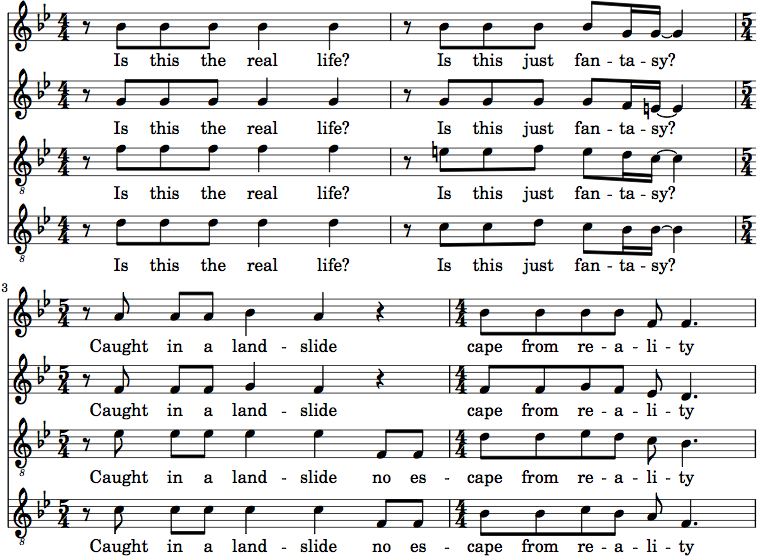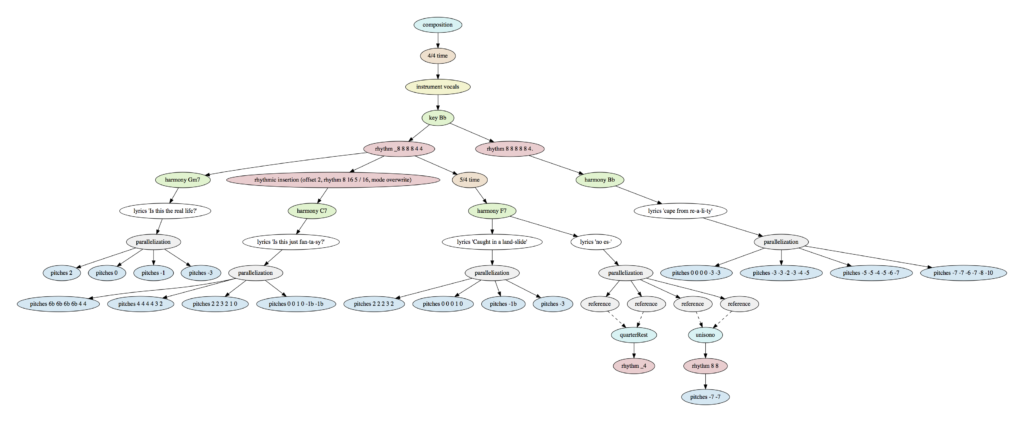This example shows a model of the a cappella introduction of Queen’s Bohemian Rhapsody. A score representation looks like this:
All parts are almost exclusively arranged homorhythmically and use the same lyrics. These redundant information do not need to be specified multiple times in MPS context tree models. A possible compressed representation is shown below (click to enlarge):
The language representation of this model is:
title "Bohemian Rhapsody"
composer "Freddie Mercury"
composition
{
time 4/4, tempo 72, instrument vocals, key Bb
{
rhythm _8 8 8 8 4 4
{
harmony Gm7, lyrics "Is this the real life?"
{
parallel
{
pitches (relative to harmony) 2
pitches (relative to harmony) 0
pitches (relative to harmony) -1
pitches (relative to harmony) -3
}
}
rhythmicInsertion mode overwrite offset 2 rhythm 8 16 5/16 , harmony C7
{
lyrics "Is this just fan-ta-sy?"
{
parallel
{
pitches (relative to harmony) 6b 6b 6b 6b 4 4
pitches (relative to harmony) 4 4 4 4 3 2
pitches (relative to harmony) 2 2 3 2 1 0
pitches (relative to harmony) 0 0 1 0 -1b -1b
}
}
}
time 5/4, harmony F7
{
lyrics "Caught in a land-slide"
{
parallel
{
pitches (relative to harmony) 2 2 2 3 2
pitches (relative to harmony) 0 0 0 1 0
pitches (relative to harmony) -1b
pitches (relative to harmony) -3
}
}
lyrics "no es-"
{
parallel
{
fragmentRef quarterRest
fragmentRef quarterRest
fragmentRef unisono
fragmentRef unisono
}
}
}
}
rhythm 8 8 8 8 8 4., harmony Bb
{
lyrics "cape from re-a-li-ty"
{
parallel
{
pitches (relative to harmony) 0 0 0 0 -3 -3
pitches (relative to harmony) -3 -3 -2 -3 -4 -5
pitches (relative to harmony) -5 -5 -4 -5 -6 -7
pitches (relative to harmony) -7 -7 -6 -7 -8 -10
}
}
}
}
}
fragment quarterRest
{
rhythm _4
}
fragment unisono
{
rhythm 8 8, pitches (relative to harmony) -7 -7
}
The source code and the corresponding representations shown in this example are also available in the github example repository.


